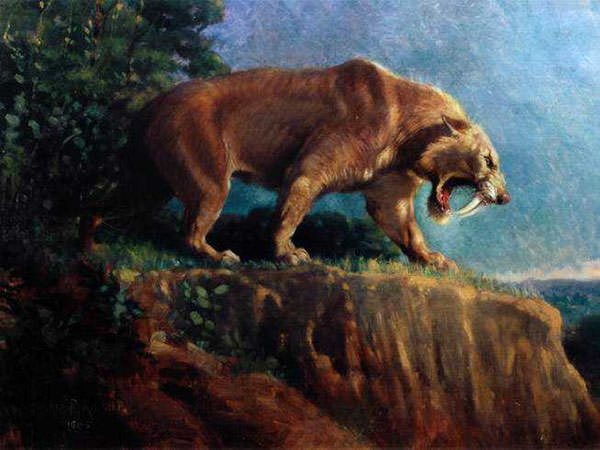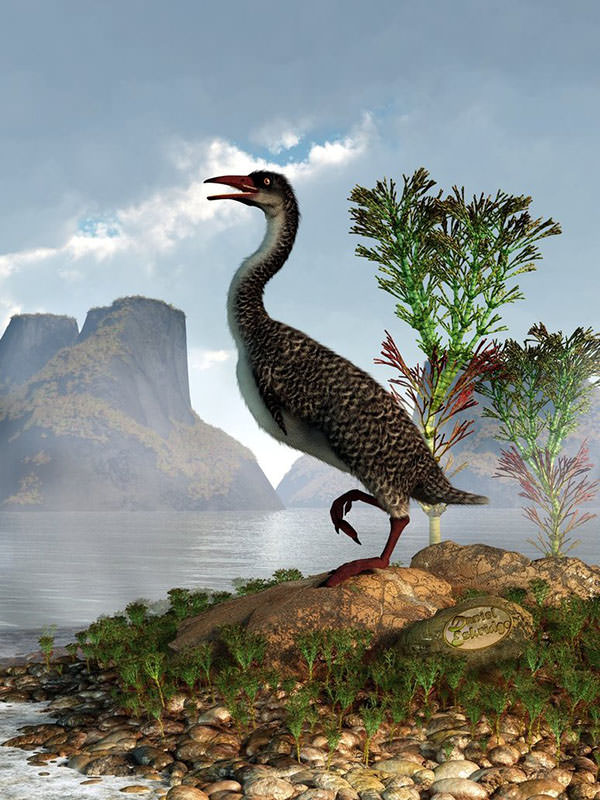30 Beautiful Recreations of Extinct Animals
Scientists estimate that throughout Earth’s history, at least five major extinctions and countless other “minor” ones have contributed to the extinction of about 99% of life forms. We are still discovering remnants of these extinct creatures, big and small, in the form of skeletal remains. Everything else that made up these creatures is left to calculated guesses and the artist’s imagination.
If you would like to know how paleo-artists (yes, it is a thing) determine the appearance of animals that no longer exist, check out this link from the Smithsonian page. However, if you’d prefer to simply admire the majesty of these creatures from the past, these 30 beautiful artists’ renditions of animals that once existed make for a great start.
Wildlife & Animal Wallpapers
Are you supporting a cause to save wild animals? or you're simply a fan of wildlife. What better... Read more
Ice age fauna of Northern Spain
This artwork shows a landscape in Northern Spain with woolly mammoths, woolly rhinoceros, equids and European cave lions.
(Image Source: Mauricio Anton)

Ancient giant Pseudo-toothed bird
Also known as Pelagornithid, the extinct ancient bird had a wingspan of 5 meters. They were among the largest birds ever to have lived.
(Image Source: livescience)

Pelagornis
Birds had teeth! Alright, they aren’t actually real teeth but protusions from the beaks that belong to these giant birds. The Pelagornis is a prehistoric pseudotooth bird which are closely related to today’s pelicans or storks, sans false teeth.
(Image Source: svartluder)

A rabbit witnesses a herd of mammoths in a snowy forest
The woolly mammoth was not the only species of mammoth and even at 15 feet tall, it isn’t exactly the biggest species either – it was a scary world to live in.
(Image Source: StockTrek Images)

Woolly Mammoth
The woolly mammoth were hunted by Homo sapiens and so they became food for early humans. The last woolly mammoths went extinct about 4,000 years ago.
(Image Source: Red Ice Creations)

Arctocyon
Arctocyon means ‘bear dog’ and it lived during the Paleocene period in North America. It is about the same size as a medium- to large-sized dog.
(Image Source: deskridge)

A Rubeosaurus roams a prehistoric environment
Fossils of Rubeosaurus have been found dating to 74.6 million years ago. It is known for having broad-based nasal horn. This is one artist’s colorful rendition of the four-legged, beaked creature.
(Image Source: StockTrek Images)

Glyptodon
The Glyptodon were giant cousins of the armadillo from the last ice age. They were about the size of a small car. They went extinct about 10,000 years ago.
(Image Source: deskridge)

Martha, The Last Passenger Pigeon
The passenger pigeon was found in the millions before they succumb to overhunting during the 19th century. The last pigeon, Martha, died at the Cincinnati Zoo on September 1, 1914.
(Image Source: John Ruthven)

Ice Age Rhino
The woolly rhinoceros, also known as Coelodonta Antiquitatis were common during the Ice Age in Europe. Scientists believe that the animal went extinct due to being hunted by humans and neanderthals.
(Image Source: deskridge)

Diprotodon optatum
Also known as the hippotamus wombat, this is the largest known marsupial to have ever walked on Earth, specifically in Australia. Its closest living relatives, understandably the wombat, and strangely, the koala.
(Image Source: StockTrek Images)

Glyptotherium arizonae
Related to the armadillo, these creatures carry shells that weigh up to a ton and can grow up to 6 feet long. The whole genus (Glyptotherium) is believed to be extinct.
(Image Source: StockTrek Images)

Olorotitan dinosaur portrait
Greek for ‘giant swan’, the Olorotitan were around during the late Cretaceous period aout 65 million years ago. It is known for having a tall, pointed crest on its head.
(Image Source: StockTrek Images)

Smilodon saber-toothed cats
They were the very few saber-toothed cats that would have come into contact with humans. This species survived until the end of the Ice Age.
(Image Source: Mauricio Anton)

Smilodon
They first appeared about 1.6 million years ago. It was the largest saber-toothed cat, much heavier and more deadly than a modern-day lion. Lucky for us, they went extinct about 11,000 years ago.
(Image Source: Charles Robert Knight)

Saber-toothed cats and bison
This artwork depicts a scene in the Pleistocene of western North America. It shows three saber-toothed cats going after a bison, much like how today’s big cats hunt their prey in the savannah.
(Image Source: Mauricio Anton)

Saber-tooth on a Rock
These animals had powerful jaws that can open up to 120 degrees. The modern-day lions can only open up to 65 degrees. The cats lived in grasslands, pine forests which provided plant-eating animals which the cats consumed.
(Image Source: deskridge)

Ancient King in a Modern Realm
This prehistoric cat also known as Smilodon fatalis was the most famous prehistoric mammal during the Pleistocene era.
(Image Source: art-of-sekhmet)

A Long Time Past, Irish Elk
The Irish elk, also know as Megaloceros giganteus, was one of the largest deer that ever lived. The most recent findings of the species dated to about 7,700 years ago in Siberia.
(Image Source: April Schumacher)

A pair of three-ton plant-eating Parasaurolophus
These animals fed on flora 75 million years ago in North America. They were known for having a hollow cranial crest.
(Image Source: StockTrek Images)

Eskimo Curlew
Also known as Numenius borealis, these birds were hunted down and the last of the species was seen several decades ago.
(Image Source: nachiii)

Hesperornis by the Sea
Talk about flightless, the Hesperornis is a wingless, aquatic bird that lived during the time of the dinosaurs. Because it had teeth, it was touted, although only briefly, as proof of the lineage between reptile and bird.
(Image Source: deskridge)

Hesperornis
These birds lived during the Campanian age about 80 million years ago. The marine bird species has teeth!
(Image Source: deskridge)

Platybelodon
If you think the elephant’s trunk is an odd appendage, check out what its ancestors had, 15 million years ago. Originally thought to sift through water vegetation, later scientists believe that the Platybelodon strip barks and leaves off trees with its jaw, teeth and mouth to feed.
(Image Source: sk00tie)

Daeodon, The Terrible Hog
The large known Daeodon species had a skull that was 3 feet long, and a stature (and face) you really don’t want to mess with. This is an ancestor of the wild boar, that lived – and died 18 million years ago – in North America.
(Image Source: deskridge)

Dinofelis
Relatives of Smilodons, the saber-toothed cats, Dinofelis had less pronounced canine teeth and a stout body to boot. They were about the size of a modern-day jaguar and lived around 5 to 1.2 million years ago.
(Image Source: deskridge)

Lycaenops
The Lycaenops walked the Earth about 200 million years ago. The name means ‘wolf face’ and it is about the size of a modern-day wolf. Despite its dog-like appearance, it is a reptile.
(Image Source: deskridge)

Dodo Hide N Seek
When it comes to a list of extinct creatures, the dodo has to make the list. A flightless bird that lived in great abundance on the island of Mauritius, with no fear of man, the dodo was hunted to extinction during the 1600s.
(Image Source: deskridge)

Backward Glance
This is part of Anne London’s gallery collection. She uses her work to raise both awareness and money.
(Image Source: Anne London)

Watercolor of a cheetah, Acinonyx jubatus
The cheetah is the fastest land animal in existence. Yes, the cheetah is still found in certain parts of Africa and Iran but it is believed that the species is too inbred to exist for long. There are less than 12500 cheetahs left in the world.
(Image Source: nhm)
